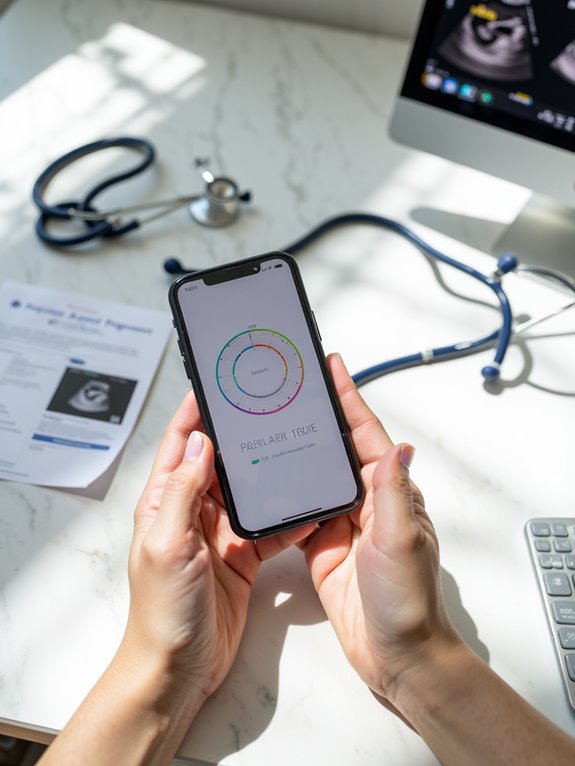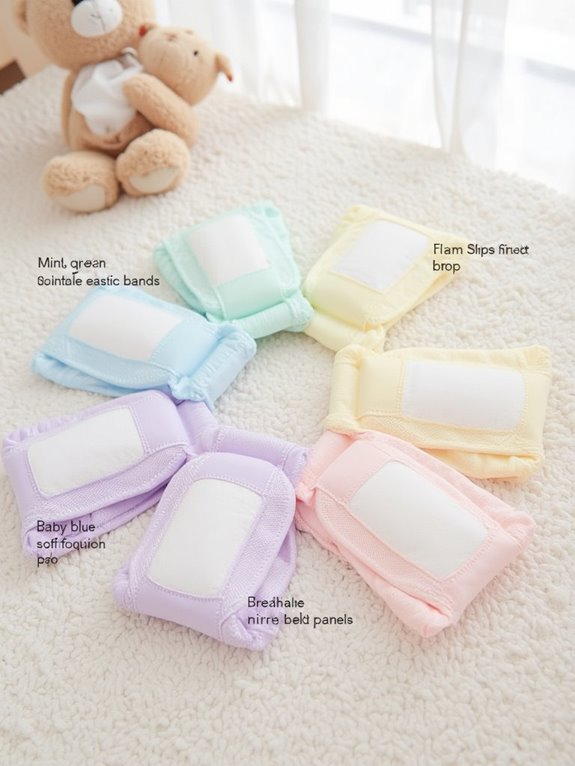Links below are affiliate links. We earn a commission on purchases at no extra cost to you. Although our opinions are based on curated research, we haven't used these products. Articles generated with AI.

3 Best Pregnancy Due Date Calculators, According to OB-GYNs
For professional pregnancy tracking, you’ll find three top-rated pregnancy wheel calculators consistently recommended by OB-GYNs: the standard 6-pack Pregnancy Wheel featuring all-encompassing fetal measurements, the Healthcare Workers’ Professional Wheel with reinforced medical-grade construction, and the EDC Guide Wheel offering integrated biometry guides. Each calculator provides accurate gestational dating, supports clinical decision-making, and meets medical standards for material quality. Exploring their specific features will help determine which best suits your practice needs.
Key Takeaways
- The Pregnology Wheel Calculator combines ultrasound measurements and LMP data for precise due date calculations while meeting clinical standards.
- MedCalc’s Digital Pregnancy Calculator integrates seamlessly with EHR systems and provides comprehensive fetal measurement guides.
- The WhatsMyDue Traditional Wheel features durable medical-grade plastic construction and clear markings for reliable long-term clinical use.
- All three calculators incorporate CRL, BPD, HC, AC, and FL measurements to enhance accuracy in early pregnancy dating.
- These tools are validated by OB-GYNs and support efficient workflow through intuitive interfaces and quick access to clinical information.
Pregnancy Wheel Due Date Calculator (Pack of 6)
Ezyaid Pregnancy Wheel (Pack of 6), Due Date OB-GYN Calculator for Pregnant Women/Healthcare...
- Excellent Accuracy: Simple and clean charting indicates 1st date of last period, conception, missed period, 1st visit dating scan, earliest possible quickening, detailed...
- Great Value: Includes fetal biometry guides such as CRL (Crown-Rump Length), BPD (Biparietal Diameter), HC (Head Circumference), AC (Abdominal Circumference) and FL...
- Easy to Use: Made of handy 12cm diameter big wheel with rotatable small wheels, just simply rotate the wheel by dragging the pointer to select LMP
The Pregnancy Wheel Due Date Calculator (Pack of 6) serves as an essential tool for healthcare providers and expectant mothers who need accurate pregnancy timeline calculations.
You’ll find this 12cm plastic wheel incredibly user-friendly – simply rotate it to your last menstrual period date to determine key milestones. The wheel shows your due date, gestational age, and important checkpoints throughout pregnancy. On the back, you’ll spot helpful fetal measurement guides including CRL, BPD, HC, AC, and FL measurements.
For medical offices and clinics, this 6-pack offers excellent value while maintaining professional-grade accuracy. It’s particularly useful for OB-GYNs, midwives, nurses, and fertility specialists who need quick, reliable calculations during patient consultations.
Best For: Healthcare providers, including OB-GYNs, midwives, nurses, and fertility specialists who need quick and accurate pregnancy calculations during patient consultations.
Pros:
- Includes 6 wheels per pack, offering great value for medical practices
- Features comprehensive fetal measurement guides on the back (CRL, BPD, HC, AC, FL)
- Simple and intuitive rotating wheel design for quick calculations
Cons:
- Limited to 12cm diameter which may be small for some users
- Plastic construction may not be as durable as other materials
- May require periodic replacement due to wear and tear from frequent use
Pregnancy Wheel Due Date Calculator for Healthcare Workers
Ezyaid Pregnancy Wheel, OB-GYN Due Date Calculator, Gestational EDC Wheel for Midwives and Health...
- Approved Accuracy: Simple and clean charting indicates first date of last period, probable ovulation, probable implantation, 1st trimester, 2nd trimester, 3rd trimester,...
- Easy to Use: Made of handy 13cm diameter big wheel with rotatable small wheels, just simply rotate the wheel by dragging and move the pointer to select LMP
- Classic Design: Small handy wheels with printed days, weeks and months for calculating lead times, to efficiently predict the approximate date of delivery
Medical professionals and healthcare workers rely on pregnancy wheel calculators as essential clinical tools that combine precision with practicality. This 13cm diameter wheel features clear markings for calculating due dates and tracking key pregnancy milestones.
You’ll find the wheel easy to operate – simply rotate to align the last menstrual period (LMP) date. It shows critical markers including:
- Probable ovulation timing
- Implantation period
- Trimester shifts
- Expected delivery date (EDC)
While some users note minor alignment variations, the wheel’s accuracy matches digital alternatives. Its durable plastic construction and large, readable print make it ideal for quick consultations and patient education.
Best For: Healthcare professionals, including OB-GYNs, midwives, and nurses who need a reliable, quick-reference tool for calculating pregnancy dates and milestones during patient consultations.
Pros:
- Durable plastic construction with large, easy-to-read print makes it practical for daily clinical use
- Quick and simple operation allows for efficient due date calculations during patient visits
- Comprehensive display of key pregnancy milestones including ovulation, implantation, and trimester stages
Cons:
- Some users report minor alignment discrepancies compared to digital tools
- Price point considered slightly high by some healthcare professionals
- Limited to physical calculations without the additional features found in digital alternatives
Pregnancy Wheel Due Date Calculator with EDC Guide
Ezyaid Pregnancy Wheel, Due Date OB-GYN Calculator with CRL, BPD, HC AC and FL Guide, EDC Wheel for...
- Excellent Accuracy: Simple and clean charting indicates 1st date of last period, conception, missed period, 1st visit dating scan, earliest possible quickening, detailed...
- Great Value: Includes fetal biometry guides such as CRL (Crown-Rump Length), BPD (Biparietal Diameter), HC (Head Circumference), AC (Abdominal Circumference) and FL...
- Easy to Use: Made of handy 12cm diameter big wheel with rotatable small wheels, just simply rotate the wheel by dragging the pointer to select LMP
Professional healthcare providers and medical staff can rely on precision timing with this specialized pregnancy wheel calculator, which includes all-inclusive EDC guides and fetal biometry measurements.
The 12cm diameter wheel features rotatable components for quick calculations. You’ll find extensive guides for:
- Crown-Rump Length (CRL)
- Biparietal Diameter (BPD)
- Head Circumference (HC)
- Abdominal Circumference (AC)
- Femur Length (FL)
Made of durable plastic, this portable tool lets you track key milestones from last menstrual period through estimated delivery date. Simply rotate the wheel’s pointers to align dates and gestational age for instant, accurate pregnancy dating calculations.
Best For: Healthcare providers, including OB-GYNs, midwives, and nurses who need a reliable tool for calculating pregnancy dates and tracking fetal measurements in clinical settings.
Pros:
- Comprehensive design includes multiple fetal biometry guides (CRL, BPD, HC, AC, FL) in one portable tool
- Durable plastic construction with easy-to-read measurements and bright colors for better visibility
- Quick and accurate calculations for pregnancy dating and milestone tracking
Cons:
- 12cm diameter may be too small for some users’ preferences
- Limited to basic calculations without advanced digital features
- Requires manual rotation and alignment which could be prone to human error
Factors to Consider When Choosing a Baby Due Date Calculator

When you’re selecting a pregnancy due date calculator, you’ll want to look at several key factors including calculation accuracy, design features, and compatibility with your healthcare provider’s systems. Your choice should account for the calculator’s material quality and durability, especially if you’re choosing a physical pregnancy wheel that you’ll use throughout your pregnancy. The calculator’s ability to perform detailed fetal assessments, including gestational age and trimester tracking, can make a significant difference in helping you stay informed about your baby’s development.
Accuracy of Calculation Methods
Since accurate due date calculations play a crucial role in prenatal care and delivery planning, it’s essential to understand the factors that influence their precision. You’ll get the most reliable results when your healthcare provider combines multiple calculation methods.
First-trimester ultrasounds offer superior accuracy compared to using your last menstrual period (LMP) alone. During these early scans, your doctor will measure your baby’s Crown-Rump Length (CRL) and Biparietal Diameter (BPD) to determine gestational age more precisely.
When choosing a due date calculator, look for ones that:
- Use both LMP and ultrasound measurements
- Account for first-trimester fetal biometry
- Follow consistent calculation methods
- Incorporate multiple data points for enhanced accuracy
- Update estimates based on ongoing pregnancy measurements
Size and Design Features
Physical characteristics and design elements play essential roles in selecting an effective pregnancy due date calculator. You’ll want to look for calculators with a compact 12-13cm wheel diameter, which offers ideal portability while maintaining clear readability.
Key Design Features:
- Durable plastic construction withstands frequent clinical use
- Large, clearly printed numbers for days, weeks, and months
- Rotating wheels for easy adjustment of LMP and gestational age
- Lightweight materials for effortless transport
When evaluating calculators, consider how the physical design supports your daily workflow. The wheel should turn smoothly without sticking, while printed information must remain legible even after repeated use. A well-designed calculator combines durability with user-friendly features, making it an essential tool for accurate pregnancy dating during patient consultations.
Medical Professional Compatibility
Beyond the physical design aspects, medical professional compatibility stands at the forefront of selecting an appropriate pregnancy due date calculator.
When choosing a calculator for clinical use, you’ll need to verify these essential features:
- Medical validation from certified OB-GYNs and healthcare institutions
- Integration capabilities with your facility’s EHR systems
- Built-in fetal biometry guides and developmental milestone markers
- Compliance with current clinical guidelines and evidence-based practices
Your calculator should provide accurate gestational age calculations that align with professional standards. It’s vital to select tools that have undergone rigorous testing and validation by medical experts. Look for calculators that offer seamless workflow integration and quick access to relevant clinical information during patient consultations. These features ensure you’re using a reliable tool that enhances your ability to provide accurate prenatal care assessments.
Durability and Material Quality
When selecting a pregnancy due date calculator, the durability and material quality directly impact its reliability and longevity in clinical settings. You’ll want to look for models constructed with high-grade, medical-grade plastic that can withstand daily handling and frequent use.
Key durability features to verify:
- Lightweight yet robust construction that won’t crack or break
- Clear, fade-resistant markings and scales for consistent accuracy
- Smooth-operating rotation mechanisms that maintain proper alignment
- Reinforced edges and joints to prevent damage from drops or impacts
Check that your calculator’s material quality meets medical standards by examining:
- The plastic’s texture and finish
- Weight distribution and balance
- Joint construction quality
- Printed marking durability
- Overall build consistency
These physical attributes ensure your calculator remains accurate and functional throughout its service life.
Fetal Assessment Capabilities
Modern pregnancy due date calculators should include robust fetal assessment capabilities that help healthcare providers monitor critical developmental milestones. You’ll want to look for calculators that offer:
- Extensive biometry measurement guides for CRL (crown-rump length), BPD (biparietal diameter), HC (head circumference), AC (abdominal circumference), and FL (femur length)
- Built-in standard growth charts for comparing your baby’s measurements
- Tools to track fetal development across multiple ultrasound appointments
These features allow your healthcare team to:
- Accurately determine gestational age
- Monitor fetal growth patterns
- Identify potential developmental concerns early
- Make informed decisions about your pregnancy care
When choosing a calculator, ensure it includes these assessment capabilities to support proper fetal monitoring throughout your pregnancy.
Ease of Operation
Selecting a user-friendly pregnancy due date calculator proves essential for accurate gestational tracking and planning. You’ll want to look for a calculator with clear, easy-to-read displays and straightforward controls that allow quick date adjustments.
Key Features to Consider:
- Simple interface with prominent buttons or dials
- Large, legible text displays
- One-step date selection process
- Quick-update capability for last menstrual period or conception date
- Minimal learning curve for operation
When evaluating calculators, ensure you can modify dates without navigating through multiple screens or complex menus. Healthcare providers and patients should be able to operate the device efficiently with little to no training. The best calculators provide immediate results after input changes, helping you stay informed about your pregnancy timeline while reducing the potential for calculation errors.
Frequently Asked Questions
How Accurate Are Online Pregnancy Calculators Compared to Ultrasound Dating?
While you might think those handy online due date calculators are your crystal ball into motherhood, they’re actually less reliable than ultrasound dating. Here’s what you need to know:
Online calculators are typically 70-85% accurate when based on your last menstrual period. However, ultrasound dating, especially in the first trimester, is up to 95% accurate within a 5-7 day window. You’ll get the most precise results from your healthcare provider using ultrasound measurements to determine your due date.
Can Twins or Multiples Affect the Accuracy of Due Date Calculations?
Yes, carrying twins or multiples can affect due date accuracy. You’ll find that standard calculators may be less reliable since multiple pregnancies often result in earlier deliveries. While singleton pregnancies typically go to 40 weeks, twins usually deliver around 36 weeks, and triplets even earlier. Your doctor will need to factor this in and use ultrasound measurements to provide a more accurate due date specific to your multiple pregnancy.
What Role Do Irregular Menstrual Cycles Play in Due Date Predictions?
If you have irregular menstrual cycles, your due date calculations may be less accurate. This is because traditional due date methods rely on having a regular 28-day cycle and known last menstrual period (LMP). When your cycles vary considerably, your healthcare provider will likely:
- Use early ultrasound measurements instead of LMP
- Monitor fetal development more closely
- Adjust due date estimates based on baby’s size and growth
These steps help guarantee more accurate predictions despite cycle irregularity.
When Should I Tell My Doctor if the Calculator Shows Unusual Dates?
Like a compass pointing in conflicting directions, unusual calculator dates can be concerning. You should contact your doctor immediately if:
- The due date seems more than 2 weeks different from what you expected
- The calculator shows a date that doesn’t align with your last period
- You’re getting widely different results from multiple calculators
Don’t wait for your next scheduled appointment – reach out to your healthcare provider right away to confirm the dates and ensure proper prenatal care timing.
How Often Should I Recalculate My Due Date During Pregnancy?
You don’t need to frequently recalculate your due date during pregnancy. After your first prenatal visit, where your doctor confirms your due date through ultrasound, this date typically remains fixed. The only times you might need a recalculation are:
- If your first ultrasound shows a significant size difference
- If your doctor notices unusual growth patterns
- If you’re unsure about your last menstrual period date
Trust your healthcare provider to determine if adjustments are needed.







